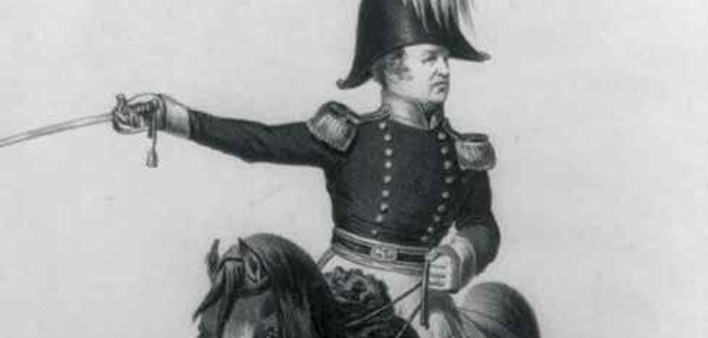Remembering Our County’s Namesake General

By Dan Heaton
Resolved, That the thanks of Congress be, and they are hereby presented to Major General Macomb, and, through him, to the officers and men of the regular army under his command, and to the militia and volunteers of New York and Vermont, for their gallantry and good conduct, in defeating the enemy at Plattsburg on the eleventh of September; repelling, with one thousand five hundred men, aided by a body of militia and volunteers from New York and Vermont, a British veteran army, greatly superior in number, and that the President of the United States be requested to cause a gold medal to be struck, emblematic of this triumph, and presented to Major General Macomb. – Resolution of Congress November 3, 1814 (Note that in the resolution, “Plattsburg” is spelled incorrectly – the “ h” is left off the end of the town’s name.)
When the Swiss Baroness Edith d’Hauteville died around Christmas time 2014, it set into motion a major event in the centuries-long history of the Macomb family. D’Hauteville was the great-greatgreat- great-great granddaughter of Gen. Alexander Macomb, the Detroit native and War of 1812 hero for whom Macomb County is named. With her death, her surviving heirs decided to sell off the family’s 30-room estate in the Swiss Alps as well as a number of her other possessions – including the gold medal that had been awarded to Gen. Macomb after he and a small troop of American soldiers essentially saved the American republic in a now-mostly forgotten battle.
Some 35 years after the Revolutionary War provided American independence from England, conflict in Europe caused tensions to flare again between the fledgling United States and its former mother country. The War of 1812 started poorly for the Americans. Most notably to those in Macomb County, perhaps, the United States lost control of Michigan territory, after suffering major defeats at the hands of British forces – along with their Native American allies – in Detroit, Monroe and on Mackinac Island. English troops then famously entered Washington, D.C. in August of 1814, setting a torch to the White House. With U.S. defeats mounting, English generals launched what looked to be a sure-fire path to total victory – an invasion of some 14,000 British troops from Canada into New York, supported by an impressive British fleet in the lower Great Lakes.
Born in Detroit in 1782, Alexander Macomb joined the American Army in 1800. In 1802, while serving with an engineer squadron, he helped build the United States Military Academy at West Point, taking some instruction there along the way – making him one of the very first officers to stand in West Point’s Long Gray Line of officers who have served their nation. By the War of 1812, Macomb was a brigadier general, in charge of about 1,500 regulars and less than 2,000 militia men in New York state, and tasked with defending the U.S. from invasion from the north. Miraculously, Macomb’s motley assembly was able to do just that – repulsing an invasion force at Plattsburgh, NY, despite being outnumbered more than four to one. Coupled with an American naval victory in a major battle in Lake Champlain and a successful American defense the next day against an invasion force in Baltimore, Md., the British decided to accept American peace terms that kept the U.S. as an intact nation – and kept the British out. And, the treaty returned Michigan back to the United States!
Back in Washington, D.C., Congress was so delighted with the victories, that it voted the “Thanks of Congress” to Macomb’s soldiers and ordered that four special gold medals be struck and awarded to Macomb and commanders from the naval battle and Baltimore victory. Macomb, the “Hero of Plattsburgh” was also promoted to major general (two stars) – the highest rank in the Army at the time.
Macomb was also named the commanding general of the U.S. Army, a position he would hold until his death. Among Macomb’s actions as the nation’s first professional commanding general, was an effort to increase pay for his enlisted soldiers, seeking to create more professionalism – and less desertion – in the ranks, something that has now become a hallmark of the U.S. military. Macomb also implemented relief payments for widows and orphans of military officers who died in the line of duty.
Popular among both with his men and nationally, Macomb died of a heart condition in 1841 at the age of 59. Sometime before his death, Macomb gave his Congressional Gold Medal to his son, also named Alexander, who in turn gave it to his daughter, Susan W. Macomb, who later married into an aristocratic family in Switzerland. The Gold Medal remained in the ownership of the Swiss branch of the family until it was finally sold at auction in February 2017. While the sale price was not disclosed, the medal was appraised at $160,000 before the sale.
Today, a number of legacies honor Macomb. He personally wrote the original court-martial manual for the Army and also authored a play about Chief Pontiac’s siege of Detroit in 1763. In addition to Macomb County, several other communities around the nation are named for the former general, as is a mountain, not far from the scene of the Battle of Plattsburgh. Statues of Macomb exist in downtown Mount Clemens and in Detroit.
Macomb’s 1841 funeral was attended by President John Tyler and former President John Quincy Adams. In 2008, he was exhumed from the Congressional Cemetery in Washington, D.C., as part of a project to repair the commemorative memorial marker at his grave. He was re-buried at the same site, again with military honors, shortly thereafter.
The identity of the new owner of the Macomb Medal was not disclosed by the German auction house that brokered the sale.
Macomb had six children and 23 grandchildren and a number of his direct descendants still bear the last name Macomb. A few members of his family have been in contact with the Macomb County Bicentennial Committee about attending events held during the county’s celebration.
Our guest writer Dan Heaton is a veteran of both the U.S. Air Force and the U.S. Navy. He writes often on military history with a Michigan connection.
All of the photos are from the U.S. Army History Center, with the exception of the images of the medal, which are from the U.S. Mint.

